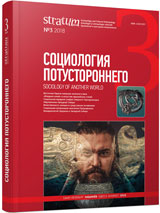Пектораль или гривна? (о соответствии термина и морфологии украшения)
Pectoral or Torque? (matching the terminology and the morphology of this adornment)
Author(s): Leonid I. BabenkoSubject(s): History, Archaeology, Fine Arts / Performing Arts, Cultural history, Visual Arts, Ancient World
Published by: Издательский дом Stratum, Университет «Высшая антропологическая школа»
Keywords: Scythia; Urartu; Thrace; pectoral; torque; Tolstaya Mogila mound
Summary/Abstract: The pectoral from Tolstaya Mogila mound was referenced to this category of adornments when it was found. However, pectorals were not so widespread with the Scythians and the genesis of this type of adornment is not quite clear. Direct succession from the Urartu pectorals is impossible due to a significant chronological gap. Thracian breast collars, which share with it many common features, are different by constitution and functional purpose. At the same time, many of the morphological elements of the pectoral from Tolstaya Mogila find many correspondences with the constitution of torques of that time: phony twisted cable-stitches, compositions of animal and human figures, and ferrules decorated with lion heads are among the most striking examples. This allows us to agree with numerous researchers who considered the pectoral from Tolstaya Mogila to be a kind of a more complex modification of torque, which the Scythians thought to be the most important insignia of a high social status of its owner. On the whole, one can notice influence of different traditions in this pectoral construction, which evolved among the local toreuts, and also the range of innovations which were borrowed from the Thracian and the Greek cultural environment.
Journal: Stratum plus. Археология и культурная антропология
- Issue Year: 2018
- Issue No: 3
- Page Range: 187-204
- Page Count: 18
- Language: Russian
- Content File-PDF

